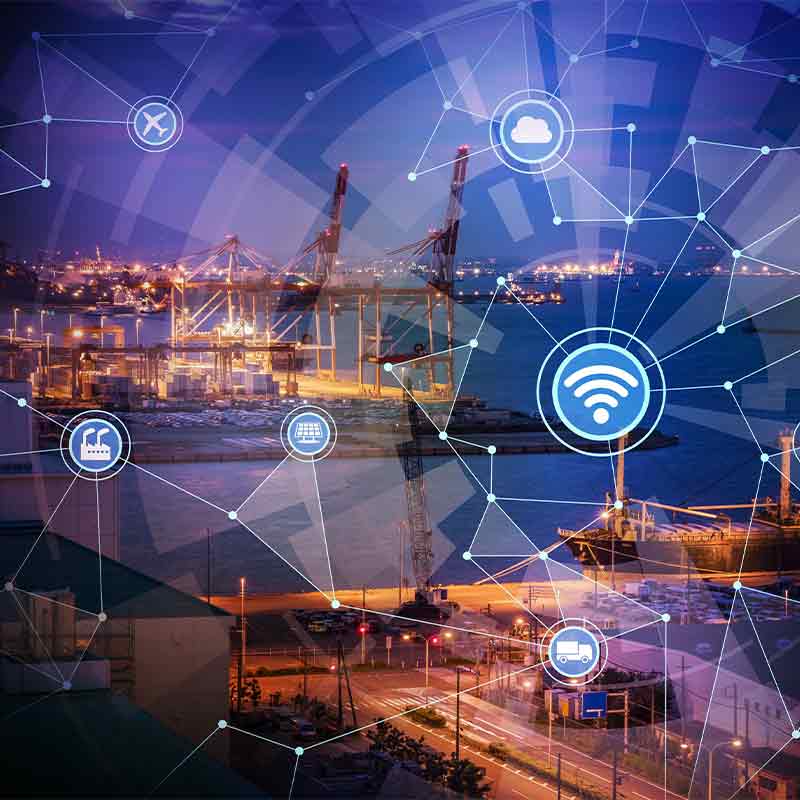IoT Connectivity Solutions M2M Connectivity Solutions in IoT
In an age entranced by technological advancements, the Internet of Things (IoT) stands out as a pivotal contributor to the evolution of smart grids. Smart grids make the most of interconnected gadgets for higher energy management, optimized efficiency, and driving sustainability. However, making certain dependable IoT connectivity types the backbone of these techniques, because it immediately impacts their efficiency and performance.

Achieving dependable connectivity in smart grids necessitates complete planning and strategy - Managed IoT Connectivity Platform. One elementary facet includes deciding on the right communication protocols. Various communication strategies, including cellular, LPWAN, and satellite tv for pc, every come with their advantages and limitations. Careful evaluation of operational necessities helps in deciding on the most applicable protocol for different use instances inside the smart grid ecosystem.
IoT Connectivity Products Six Major IoT Connectivity Technologies
Data safety emerges as a significant part of reliable connectivity. As smart grids are increasingly prone to cyber threats, implementing strong security measures is crucial. This includes encryption protocols, secure communication channels, and frequent software program updates to guard knowledge integrity. A secure IoT environment fosters belief amongst stakeholders and encourages wider adoption of smart grid technologies.
Another pivotal space includes making certain low latency communication. Real-time knowledge transmission is imperative for monitoring and managing energy distribution successfully. A network’s capability to offer rapid communication can significantly affect the responsiveness of grid operations, indicating the significance of infrastructure that may help high-speed connections. Investing in advanced technologies can help mitigate latency challenges.
IoT Connectivity Policy Ultimate Guide to IoT Connectivity
Scalability is equally very important for attaining continuous and reliable connectivity. Smart grids will need to have the capability to deal with an ever-increasing variety of sensors, devices, and users. Future-proofing designs and adapting modular IoT solutions can be positive that the infrastructure remains useful as the network expands and extra devices are integrated. This flexibility aids in minimizing disruptions and sustaining the overall efficiency of smart grids.
Energy administration plays a vital position in IoT connectivity inside smart grids. Devices want to maintain operational efficiency while consuming minimal energy. Smart meters and energy-efficient protocols can monitor and handle the consumption of devices, thereby guaranteeing consistent operational performance. Implementing energy management solutions optimizes not only device efficiency but additionally network reliability.
Interoperability is vital for seamless integration of units and methods. Different producers might create units using numerous standards, complicating communication throughout the smart grid. Promoting interoperability between gadgets can reduce issues and create a unified community that features efficiently. Establishing common standards for gadget compatibility accelerates integration and bolsters reliability.
Network redundancy is a vital strategy to ensure ongoing connectivity. By incorporating multiple communication pathways, smart grids can maintain steady operation even when a single network path fails. This layered method minimizes downtime and preserves the reliability of data transmission. It involves a strategic mix of wired and wi-fi choices to create a resilient network structure.
IoT Connectivity Definition Future of IoT Technology Connectivity
Monitoring and analytics are powerful instruments for enhancing connectivity reliability. Continuous oversight of community efficiency allows for the identification of potential points before they escalate into important considerations. Advanced analytics can predict network conduct and enable proactive maintenance, ensuring that the infrastructure remains sturdy and effective over time.
Collaboration between stakeholders performs a vital function in developing dependable IoT connectivity in smart grids. Utility firms, know-how providers, and regulatory our bodies must work collectively to develop standards, share finest practices, and conduct research on rising technologies. This partnership creates a stronger ecosystem, encouraging innovations that enhance the general reliability of the grid.
Nb-IoT Connectivity Essential Types of IoT Connectivity
User schooling and engagement are sometimes overlooked but essential elements in establishing and sustaining IoT connectivity. By providing customers with data about the functionalities and operations of smart grid technologies, stakeholders can foster user-friendly interfaces and promote accountable utilization. An knowledgeable client base finally contributes to the stability and reliability of the overall community.
As smart grid technologies proceed to evolve, incorporating developments in artificial intelligence and machine learning can pave the way in which for enhanced connectivity. These technologies facilitate predictive maintenance, allowing for real-time changes and well timed interventions. By leveraging AI and analytics, smart grids can become more adaptive, refining their operations based mostly on real-world knowledge and behaviors.
Managed IoT Connectivity Services Basics of Global IoT Connectivity
In conclusion, ensuring reliable IoT connectivity in smart grids encompasses a multifaceted approach, integrating careful strategy, technological advancements, and proactive administration. From selecting acceptable communication protocols to fostering collaboration amongst stakeholders, every side contributes to the overarching aim of making an environment friendly and secure energy grid. Continuous adaptation to emerging technologies and willingness to evolve with business read more demands will ultimately guide smart grids toward a more reliable and resilient future.
- Deploy resilient communication protocols designed for low-latency and high-reliability data transmission inside smart grids.
IoT Connectivity Definition Infrastructure and Connectivity for IoT Devices
- Implement community redundancy by using various communication pathways, guaranteeing continued operation during outages or failures.
- Regularly update firmware and software program throughout all IoT devices to guard towards vulnerabilities and enhance connectivity resilience.
- Leverage edge computing to course of data nearer to the supply, reducing bandwidth necessities and enhancing response times.
- Establish stringent safety measures, including encryption and authentication, to guard the integrity of data being transmitted.
Nb-IoT Connectivity IoT Connectivity as the Foundation
- Utilize mesh networking capabilities, which allow gadgets to interconnect, enhancing coverage and reliability in challenging environments.
- Conduct regular community performance assessments to establish bottlenecks and optimize communication efficiency all through the grid.
- Invest in scalable infrastructure to accommodate future expansion of IoT units and evolving technologies with out compromising connectivity.
IoT Connectivity Managementplatform Six Major IoT Connectivity Technologies

- Maintain a proactive incident response plan to shortly tackle connectivity interruptions and restore services efficiently.
- Foster collaboration between utility companies and expertise suppliers to ensure alignment on connectivity standards and protocols.
What are the key challenges in making certain reliable IoT connectivity in smart grids?
IoT connectivity in smart grids faces challenges such as community congestion, energy outages, and cybersecurity threats. To tackle these, it's important to implement sturdy communication protocols, put money into redundant techniques, and undertake sturdy safety measures.
How do I choose the right connectivity protocol for my smart grid IoT devices?
Managed IoT Connectivity Evaluating IoT Connectivity Technology Pros and Cons
Selecting the proper protocol involves evaluating the particular requirements of your devices, including data fee, range, and energy consumption. Common protocols embrace LoRaWAN, Zigbee, and cellular networks. A thorough wants assessment will information you in making your greatest option.
What role does encryption play in ensuring dependable IoT connectivity in smart grids?
IoT Satellite Connectivity Choosing the Right IoT Connectivity Option
Encryption is essential for securing data transmission in smart grids. It prevents unauthorized entry and protects delicate information from being intercepted. Implementing sturdy encryption standards enhances the general reliability and security of IoT connectivity.
How can I scale back latency in IoT communications inside a smart grid?
To scale back latency, contemplate optimizing network configurations, using edge computing to course of information closer to the source, and deciding on high-performance communication technologies. Prioritizing real-time data transmission can significantly enhance response occasions.
What methods can help keep connectivity throughout energy outages?
IoT Connectivity Market Future of IoT Technology Connectivity
Implementing battery backup techniques, energy-efficient gadgets, and different energy sources (like solar energy) can help preserve IoT connectivity throughout energy outages. Additionally, ensuring that your network design includes redundancy try this web-site will mitigate connectivity issues.
How do I assess the scalability of my IoT connectivity solution?

To assess scalability, analyze your present and future system requirements, together with knowledge processing wants and network site visitors masses. Choose a solution that may easily broaden its capacity and combine with new technologies without important disruptions.
Connectivity Management Platform IoT Modern Solutions for IoT Connectivity
What components should I think about when deploying IoT options for smart grid monitoring?
Consider elements like protection area, value, ease of deployment, and interoperability with existing methods. Also, be sure that your chosen answer is versatile enough to adapt to evolving know-how and regulatory necessities in the energy sector - Connectivity Management IoT.
IoT Connectivity Platform Choosing the Right IoT Connectivity Option
How can I improve the security of my IoT devices in a smart grid environment?
Improving safety entails implementing multi-layered defenses, conducting common security assessments, and keeping firmware updated. Employing sturdy authentication measures and steady monitoring of network site visitors can even assist safeguard your IoT gadgets.
IoT Connectivity Platform Managed Platform for IoT Connectivity
What are the advantages of utilizing a dedicated community for IoT in smart grids?
A devoted network minimizes interference from other gadgets, providing more dependable and consistent connectivity. It permits for tailored performance optimizations and enhanced safety, ensuring that your smart grid operates effectively and successfully without outdoors disruptions.